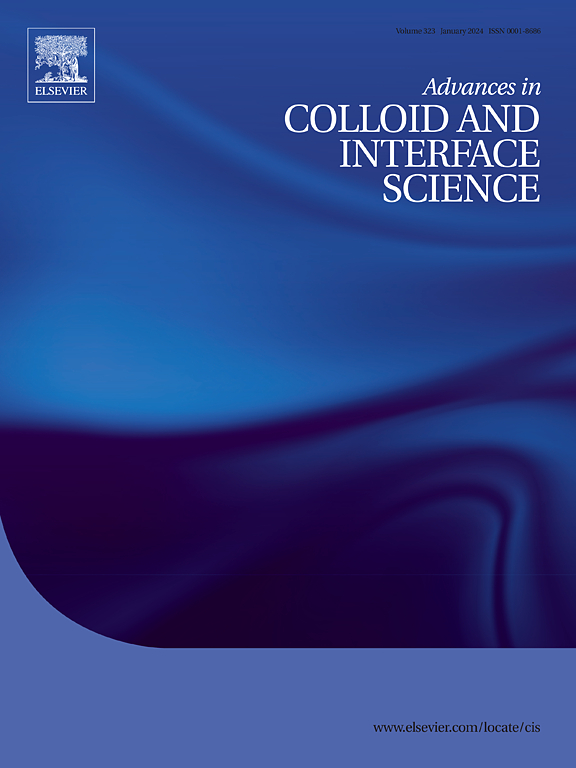Lignin nanoparticle-stabilized pickering emulsion: Mechanism, influencing parameter, and emerging application
IF 15.9
1区 化学
Q1 CHEMISTRY, PHYSICAL
引用次数: 0
Abstract
Pickering emulsions using solid particles as stabilizers have attracted considerable interest due to their unique properties, environmental protection, high stability, and cost-effectiveness. However, the current solid particles used as stabilizers have been unable to meet the demands for sustainable development. Lignin nanoparticles (LNPs) are nanoscale particles derived from lignin, a complex biopolymer found in the cell walls of woods and plants. In recent years, LNPs have been widely used to stabilize Pickering emulsions due to its abundance, nanometer size, large specific surface area, good wettability, non-toxicity, and biodegradability. In this review, we overview the recent advances in the LNP-stabilized Pickering emulsion and their applications in a wide spectrum of emerging fields. The structure, preparation, and safety of LNPs are briefly overviewed. Then, the stabilization mechanism of LNP-stabilized Pickering emulsion is introduced. Next, two types of LNP-stabilized Pickering emulsion (i.e., unmodified and modified LNPs), their influencing factors, and physiochemical properties are comprehensively discussed. The recent advances in the application of LNP-stabilized Pickering emulsions in five areas are subsequently outlined, i.e., i) nanocomposites, ii) two-phase catalysis, iii) biomedicine, iv) daily skincare products, and v) enhanced oil recovery. Finally, the prospects of LNP-stabilized Pickering emulsion in the aforementioned fields are proposed.

木质素纳米颗粒稳定的酸洗乳液:机理、影响参数和新兴应用
以固体颗粒为稳定剂的酸洗乳由于其独特的性能、环保、高稳定性和高性价比而引起了人们的广泛关注。然而,目前固体颗粒作为稳定剂已经不能满足可持续发展的需要。木质素纳米颗粒(LNPs)是由木质素衍生的纳米级颗粒,木质素是一种复杂的生物聚合物,存在于树木和植物的细胞壁中。近年来,LNPs因其丰富、纳米尺寸、大比表面积、良好的润湿性、无毒性和可生物降解性而被广泛用于稳定皮克林乳状液。本文综述了近年来lnp稳定皮克林乳状液的研究进展及其在新兴领域的广泛应用。本文对LNPs的结构、制备和安全性进行了简要综述。然后介绍了lnp稳定皮克林乳状液的稳定机理。然后,对两种稳定lnp的Pickering乳状液(即未改性lnp和改性lnp)及其影响因素和理化性质进行了全面讨论。随后概述了lnp稳定皮克林乳液在五个领域的最新应用进展,即:i)纳米复合材料,ii)两相催化,iii)生物医学,iv)日常护肤品,v)提高采收率。最后,展望了lnp稳定皮克林乳状液在上述领域的发展前景。
本文章由计算机程序翻译,如有差异,请以英文原文为准。
求助全文
约1分钟内获得全文
求助全文
来源期刊
CiteScore
28.50
自引率
2.60%
发文量
175
审稿时长
31 days
期刊介绍:
"Advances in Colloid and Interface Science" is an international journal that focuses on experimental and theoretical developments in interfacial and colloidal phenomena. The journal covers a wide range of disciplines including biology, chemistry, physics, and technology.
The journal accepts review articles on any topic within the scope of colloid and interface science. These articles should provide an in-depth analysis of the subject matter, offering a critical review of the current state of the field. The author's informed opinion on the topic should also be included. The manuscript should compare and contrast ideas found in the reviewed literature and address the limitations of these ideas.
Typically, the articles published in this journal are written by recognized experts in the field.

 求助内容:
求助内容: 应助结果提醒方式:
应助结果提醒方式:


